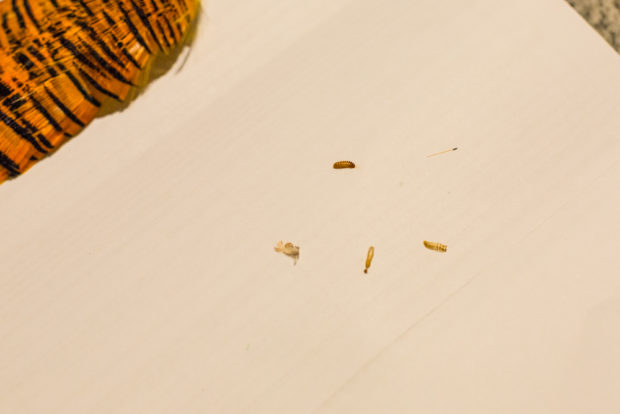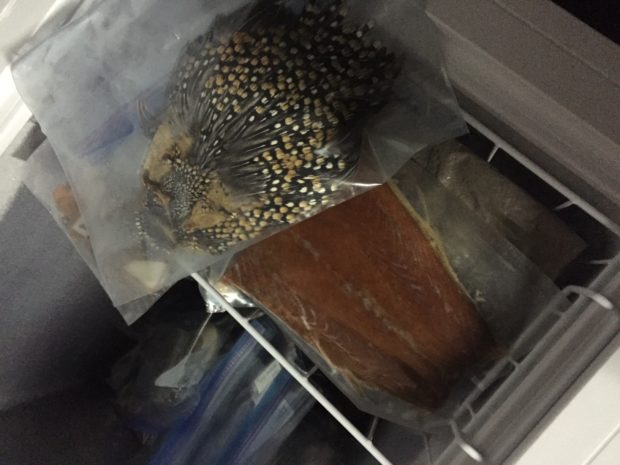
The offending evidence highlighted against paper.
I’ve got bugs in my jungle cock.
(For those who are new to fly tying, or who got here from some hilarious mistaken Google search, the feathers of the male junglefowl have been used in salmon flies since the 19th century for the impressionistic way the “rails” or individual feather mimic eyes on the side of flies. Sourced from peninsular India, they are remarkably beautiful features, and remarkably expensive.)
In looking for some material to complete a salmon tube fly I was tying, I found what every fly tyer fears: the specs of chewed fibers, and the little husk of a body. The evidence was clear: bugs had gotten into my tying materials, and they had expensive taste.
The question of what to do next is one that has nearly as many answer as fly fisherman. It’s a topic on which much has been said, but on which few seem to agree. So what I’m going to do is outline what I’ve done, and what I plan to do next.
First, I yelled, loudly, in a string of words I won’t print here. Then I poured myself a bourbon.
After that, I figured out a plan of action. I wanted to do some more reading about the problem, and what to do about it, so I needed to take action that would buy me time.
What I did first was to bag all of the materials I found that were affected and I put them into heavy Ziploc bags. I wrote on these bags the date, and then I put them into a chest freezer I have in the basement. Ironically, they ended up next to an on top of slabs of smoked Atlantic salmon smoked on the very river that I was tying flies for.

I confess that I’ve heard a variety of different things about putting materials into the freezer. Some people say it works. Some people say the bugs can hibernate. But no one says they keep on eating right through the deep freeze, so I thought it would buy me time. I did some research, and spoke with some people and found out a couple of things.
Here’s what you need to know:
- From what I’ve read, it’s the larvae that are the ones you have to worry about. They are the ones that eat their way through everything.
- Heavy plastic bags only slow them down, but don’t stop them. If you look closely, you’ll find they chew tiny holes right through the bags.
- Cedar is not an effective repellent in most cases. For one, the cedar planks you buy are mostly dried out, and aren’t nearly as effective as new, fresh cedar — something that simply isn’t an option at scale.
- Mothballs are noxious, and potentially hazardous to your health if handled repeatedly over years. It also is only a repellent; it does not kill bugs.
- You will never really know if you got rid of all of them.
- And you should never introduce outside fly tying materials to your collection without a great deal of caution.
I was speaking with Dave, down at Concord Outfitters when he worked there, about a new trove of fly tying materials I had inherited. He was visibly worried; he wouldn’t buy second hand materials, he said, due to the risk of bugs. When I found the larvae shells in my jungle cock, I thought of Dave. He had been right.
Through all of this reading, I started hatching a plan. Here were my goals:
Here’s what I wanted to do:
- To figure out a permanent storage solution that was as bug-proof as possible;
- To do so in a way that didn’t make my fly tying to stink to high heaven;
- And one that didn’t make my flies stink just as badly (I believe, strongly, that fish have a strong sense of smell);
- To do so in a way that was easily trackable;
- Replicable across my materials; and
- Didn’t cost an arm and a leg.
With those goals, here’s the plan I’ve laid out for myself.
Put your material in the cryo freezer, for a long time. From what I can tell, storing these materials in the deep chest freezer at very cold temperatures for a long time will be effective. I was lucky in that my busiest tying season is the winter; when fishing season starts, I spend my time on the water. So I’m putting a lot of my materials into the freezer until September or October. That should be sufficient.
Write a date on all of the packages, so you can track time. I found a sharpie does the trick, and doesn’t wipe off in the freezer.
Get storage bins. For free. I know this may sound impossible, but here’s a great trick I learned from a good friend: the plastic tubs that supermarkets use to store fish is make the perfect fly tying bins. Think about it: they are nearly air tight, they are built to stack, they are light, and — best yet — you can get them for free. Try walking into a big supermarket, or into a WholeFoods or something, and asking them if they can spare a few, or if they have any leftovers. You might be surprised.
Wash some materials. I had some old materials that I inherited from some old friends, and they capes were looking a bit bedraggled. So before throwing them into the deep freeze, I washed a few of them. I plan to post about this, but in short, the process was simple: I washed them in a gentle detergent by hand in a large roasting pan, then dried them with a hair dryer. They came out looking like brand new Metz capes. (Well, almost.)
Don’t use moth balls. Seriously. I think the moth ball craze reduces people’s catch rate. Actually, with that said — go for it. It means all the more fish for me.
Instead, use alternatives. Like a tic collar. Or a pest strip. These kill bugs, not just repel them. That’s an important difference.
Wash out your current bins. I took a three pronged approach to this. First, I took my Shop Vac to all of the drawers of my tying desk. This provided the most sucking action I could think of. Second, I wiped them disinfecting wipes to all of the drawers to pick up some finer materials — hairs, dust, maybe small eggs? Finally, I took a q-tip dipped in rubbing alcohol and swabbed out the corners. Yes, this took a long time. And yes, I’m glad I did it.
Along the way, I tried a few things, and would have a few recommendations:
What Not To Do:
- Do NOT microwave your materials. I tried this, after reading warnings on the internet, just to see what it would be like. After enough time to cook the larvae, it’s a bad scene. If my experience is any indication, I wouldn’t try it.
- Also, don’t try to dry them in the oven, even at a cleverly low temperature. I won’t say anything more.
- Do not spread baking powder on them. This is an absolute mess. Thank you, internet, for this handy and completely useless tip.
I hope this is helpful. I’ll post about the cleaning method I used. For now — I’m off to check on my bugs!

